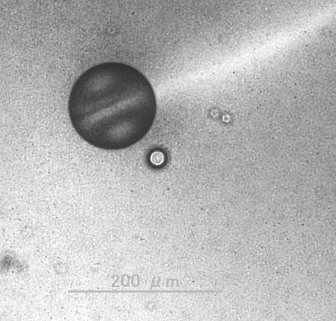EON Workshop: Sensors, Motors and Behaviour at the Origin of Life
EON will hold an international workshop at ELSI on July 26-28, 2017.
Organizers: Matthew Egbert 1 Martin Hanczyc 2
1 Lecturer, University of Auckland, NZ
2 Principal Investigator, Centre for Integrative Biology, University of Trento, Italy
Venue: ELSI Hall in ELSI-1 bldg., Tokyo Institute of Technology, Tokyo, Japan.
Title: Sensors, Motors and Behaviour at the Origin of Life

Behaviour precedes evolution
The behaviour of modern organisms often involves intricate sensors and sophisticated motors that are too complicated to have spontaneously emerged in a prebiotic world. Evolution was required to produce these structures and for this reason, it might seem counterintuitive to consider the possibility that behaviour existed before evolution. However, numerous simple physical systems demonstrate surprisingly life-like behaviours. Motile oil-droplets (e.g., Hanczyc et al. 2014), autocatalytic reaction-diffusion spots (Virgo 2011), and ramified charge-transportation networks (Kondepudi et al. 2015) all move toward environments that benefit their persistence and away from damaging environments. These systems thus demonstrate a pre-biotic form of self-preservation, which in turn suggests that functionalities typically associated with life, such as sensing and actuating could have been available in pre-evolutionary contexts. In this workshop we will consider in detail what kinds of sensors, motors and behaviors might have been available to the earliest organisms and proto-organisms, and the role that these systems might have played in facilitating the emergence of life.
One focus of the workshop will be upon metabolism-based behaviours, where instead of responding directly to environmental properties (such as the presence of sugar), organisms act in response to how efficiently their metabolism is operating (e.g. in response to the state of the electron transport system). This kind of behaviour is observed in various modern bacteria (see e.g. Alexandre et al., 2000), and it is directly comparable to the mechanisms underlying the pre-biotic self-preserving behaviours mentioned above.
A number of recent theoretical contributions have suggested that metabolism-based behaviors can improve robustness, adaptivity and evolvability, by
(1) driving behaviour that responds appropriately to phenomena that neither they nor their ancestors have ever previously experienced (Egbert et al. 2012);
(2) driving behaviour that takes into account the history of the organism, such as which resources it has recently acquired, if it has sustained damaged, if a symbiont or parasite is affecting its metabolic dynamics etc. (Egbert et al. 2009; 2010; 2012, Egbert & Perez-Mercader, 2016);
(3) integrating numerous and simultaneous environmental effects into a coherent and self-preserving response without requiring any extra “computational” machinery for weighing the influence of the different factors (Egbert et al. 2009; 2010).
(4) allowing an organism to compensate behaviorally for changes in its internal operation, such as modification to a metabolic pathway (Egbert et al. 2010; 2012; Egbert & Perez-Mercader, 2016).
Given that metabolism-based behaviour (i) improves robustness, adaptivity and evolvability; (ii) is found in simple physical systems that almost certainly predate biological evolution and (iii) is also found in modern organisms, we set out to investigate The Origins of Behaviour in the context of the Origins of Life.
The invited participants come from a wide variety of backgrounds including experts in bacterial chemotaxis, complex chemical and physical systems, philosophy of biology, philosophy of science, computational modelling of complex biological systems, mathematical modelling of sensorimotor-based adaptive behaviour, artificial life, synthetic biology and artificial chemistry. It is our hope that gathering this group together will provide a community that will foster innovative inter- and trans-disciplinary research.
List of speakers
(the following schedule is tentative)
Day 1:
Matthew Egbert
Martin Hanczyc
Gladys Alexandre
Jim Dixon
Alex Penn
Day 2:
Xabier Barandiaran
Dilip Kondipudi
Nathaniel Virgo
Paul Schlumbom
Takashi Ikegami
Takeshi Sugawara
Emily Parke
Taro Toyota
Day 3:
Tom Froese
Karen Ottemann
Eduardo Izquierdo
Jitka Cejovka
Peter Cariani
Relevant Literature
Alexandre G, Greer SE, Zhulin IB. Energy Taxis Is the Dominant Behavior in Azospirillum brasilense. Journal of Bacteriology. 2000;182(21):6042-6048.
Bartlett, S and Bullock S (2015) Emergence of competition between different dissipative structures for the same free energy source. In Advances in Artificial Life, ECAL 2015. MIT Press, 415-422
Braitenberg V (1986) Vehicles: Experiments in Synthetic Psychology. Cambridge, Mass.: MIT Press.
Brooks R (1991) Intelligence without representation. Artificial Intelligence. 47(1–3):139–59.
Kondepudi D, Kay B, and Dixon J (2015) End-directed evolution and the emergence of energy-seeking behavior in a complex system. Phys. Rev. E 91, 050902(R)
Egbert M, Pérez-Mercader J. (2016) Adapting to Adaptations: Behavioural Strategies that are Robust to Mutations and Other Organisational-Transformations. Scientific Reports. 6 (Article number: 18963).
Egbert M, Barandiaran X, Di Paolo E. (2012) Behavioral Metabolution: The Adaptive and Evolutionary Potential of Metabolism-Based Chemotaxis. Artificial Life. 18(1):1-25.
Egbert M, Barandiaran X, Di Paolo E. (2010) A Minimal Model of Metabolism-Based Chemotaxis. PLoS Computational Biology.6(12):e1001004.
Egbert M, Di Paolo E, Barandiaran X. (2009) Chemo-ethology of an Adaptive Protocell: Sensorless sensitivity to implicit viability conditions in Proceedings of the Tenth European Conference on Artificial Life, ECAL09, Budapest. Springer, Berlin.
Froese T, Virgo N and Ikegami T (2014) Motility at the Origin of Life: Its Characterization and a Model Artificial Life 20:1, 55-76
Hanczyc M (2014) Droplets: Unconventional Protocell Model with Life-Like Dynamics and Room to Grow. Life 4.4: 1038-1049.
Hanczyc M (2011) Metabolism and motility in prebiotic structures Phil. Trans. R. Soc. B 366 pps. 2885-2893
Hanczyc N, Ikegami T (2010) Chemical basis for minimal cognition Artificial Life 16 (3), 233-243
Hanczyc M, Toyota T, Ikegami T, Packard N, Sugawara T (2007)Fatty Acid Chemistry at the Oil−Water Interface: Self-Propelled Oil Droplets Journal of the American Chemical Society 129 (30), 9386-9391 DOI: 10.1021/ja0706955
Izquierdo E, Beer R, (2016) The whole worm: brain–body–environment models of C. elegans, Current Opinion in Neurobiology, Volume 40, Pages 23-30, ISSN 0959-4388
Nicolis, Gregoire, and Ilya Prigogine. Self-organization in nonequilibrium systems. Wiley, New York, 1977.
Noireaux V, Libchaber A (2004) A vesicle bioreactor as a step toward an artificial cell assembly PNAS 21;101(51):17669–74.
Virgo N (2011) Thermodynamics and the structure of living systems. Doctoral thesis (DPhil), University of Sussex.
[…] EON Workshop: Sensors, Motors and Behaviour at the Origin of Life […]